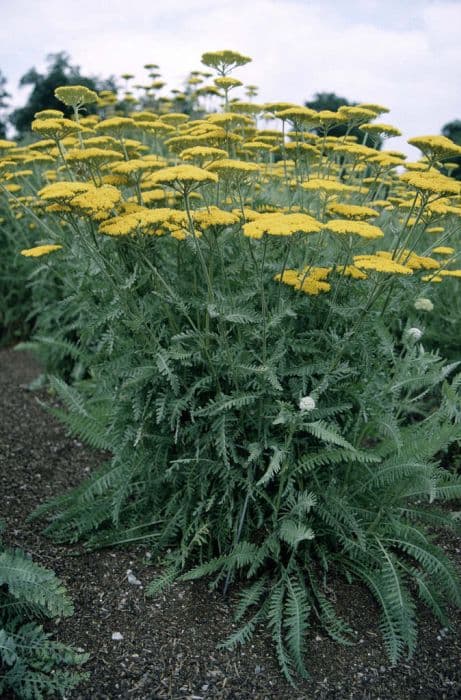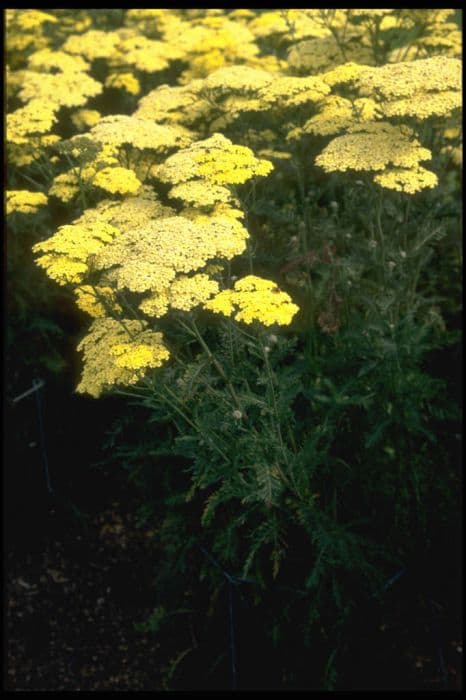Tickseed Coreopsis grandiflora 'Kelvin Harbutt'

ABOUT
Coreopsis grandiflora 'Kelvin Harbutt' is a vibrant flowering perennial known commonly as large-flowered tickseed. This plant is distinguished by its showy, daisy-like flowers. The blooms have an intense golden-yellow color that stands out in any garden setting. The center of each flower is typically a darker yellow or brownish hue, which creates a lovely contrast with the bright petals. The flowers are borne on long, slender stems that rise above the foliage, making them a choice pick for cut flower arrangements. The foliage of 'Kelvin Harbutt' is equally attractive, with slender green leaves that have a delicate, ferny appearance. The leaves are often lance-shaped, sometimes with lobed or serrated edges, which adds a fine texture to the plant's overall appearance. When in full bloom, the plant displays a profusion of flowers, creating a dense canopy of golden hues. The flowers and foliage together contribute to a bushy, mounded form that brims with life and color throughout its blooming season. As it is a member of the Asteraceae family, its blossoms provide essential nectar to pollinators such as bees and butterflies, playing a supportive role in local ecosystems.
About this plant
 Names
NamesFamily
Asteraceae
Synonyms
Large-flowered Tickseed, Golden Tickseed, Common Coreopsis, Garden Tickseed
Common names
Coreopsis drummondii, Coreopsis grandiflora var. drummondii, Coreopsis lanceolata var. villosa, Coreopsis saxicola.
 Toxicity
ToxicityTo humans
Coreopsis grandiflora, commonly known as large-flowered tickseed, is not known to be toxic to humans. While it is generally considered safe, it is always advisable to avoid ingesting plants that are not explicitly meant for consumption as individual sensitivities can vary.
To pets
Coreopsis grandiflora, or large-flowered tickseed, is not commonly listed as a toxic plant to pets. It is generally considered non-toxic to cats and dogs. However, if a pet ingests a large amount of any non-food plant, they may exhibit signs of gastrointestinal discomfort such as vomiting or diarrhea. Always monitor pets to ensure they are not eating plants that they shouldn't be.
 Characteristics
CharacteristicsLife cycle
Perennials
Foliage type
Deciduous
Color of leaves
Green
Flower color
Yellow
Height
2 feet (60 cm)
Spread
2 feet (60 cm)
Plant type
Herb
Hardiness zones
5
Native area
North America
Benefits
 General Benefits
General Benefits- Attracts Pollinators: The bright, showy flowers of the Coreopsis grandiflora 'Kelvin Harbutt', commonly known as Tickseed, are attractive to bees, butterflies, and other beneficial pollinators.
- Low Maintenance: Tickseed is generally easy to care for and does not require frequent watering or fertilizing once established.
- Drought Tolerant: After establishment, Tickseed has good drought tolerance, making it suitable for dry or xeriscape gardens.
- Long Blooming: Tickseed has a long flowering season, providing continuous color in the garden from early summer until fall.
- Deer Resistant: The plant is known to be resistant to browsing by deer, which can be beneficial in areas where deer predation is a problem.
- Versatile Use: Tickseed can be used in a variety of garden settings, including borders, containers, and as a groundcover.
- Cheerful Aesthetic: With its bright yellow flowers, Tickseed adds a cheerful and vibrant aesthetic to any garden or landscape.
- Soil Adaptability: Tickseed can adapt to various soil types, although it prefers well-drained soil.
- Cutting Garden Addition: The flowers are suitable for cutting and can add beauty to floral arrangements.
 Medical Properties
Medical PropertiesThis plant is not used for medical purposes.
 Air-purifying Qualities
Air-purifying QualitiesThis plant is not specifically known for air purifying qualities.
 Other Uses
Other Uses- The tall and sturdy stems of Coreopsis Grandiflora can be used for making natural plant supports for other, more delicate garden plants that require staking.
- Dried flower heads of the Coreopsis Grandiflora can be used in craft projects, such as making potpourri or for adding texture and color to dried floral arrangements.
- The vibrant flowers can be used as a natural dye for fabrics, yielding a range of sunny yellow to golden hues.
- The leaves and stems, when crushed, can sometimes be used as an insect repellent in the garden, though their effectiveness can vary.
- Coreopsis Grandiflora can be planted in outdoor pet areas as they are non-toxic to dogs and cats, adding beauty without risking pet health.
- The seeds of Coreopsis Grandiflora can be used to feed birds, particularly in the fall and winter months when other food sources are scarce.
- Photographers and artists may use Coreopsis Grandiflora as a subject or backdrop for their work due to its striking color and form.
- Its blooms can be floated in water bowls or fountains for a decorative touch during outdoor summer events or gatherings.
- When establishing a wildlife garden, Coreopsis Grandiflora can attract beneficial insects such as bees and butterflies, promoting pollination.
- Coreopsis Grandiflora's dense growth can be functional as a groundcover, helping to reduce soil erosion in sloped garden areas.
Interesting Facts
 Feng Shui
Feng ShuiThe Coreopsis is not used in Feng Shui practice.
 Zodiac Sign Compitability
Zodiac Sign CompitabilityThe Coreopsis is not used in astrology practice.
 Plant Symbolism
Plant Symbolism- Love: Coreopsis, often known as tickseed, is commonly associated with love and affection, making it a perfect plant to symbolize warmth and heartfelt care.
- Optimism: With its bright, sunny blooms, tickseed embodies positivity and the power of looking on the bright side of life.
- Good Fortune: Some cultures believe that tickseed brings good luck, making it a symbol of hope for a prosperous future.
- Happiness: The vibrant petals of tickseed serve as a symbol for joy and happiness, an embodiment of cheerfulness in the garden.
 Water
WaterTickseed requires moderate watering, especially during its growing season in spring and summer. It's best to water the plant when the top inch of soil feels dry to the touch. A deep, thorough watering is recommended, ensuring you wet the soil to a depth of at least 8 inches every time you water. This might translate to approximately 1 gallon for an established plant every week, depending on the weather conditions and soil drainage. It's important to avoid overwatering as Tickseed does not like to sit in wet soil, which can lead to root rot and other fungal issues. During the winter months, reduce the frequency of watering as the plant goes dormant.
 Light
LightTickseed thrives in full sun, requiring at least six to eight hours of direct sunlight daily. The best spot for this plant would be in an area that gets unfiltered sunlight for the majority of the day. However, in extremely hot climates, some afternoon shade can be beneficial to prevent scorching. Avoid planting Tickseed in deep shade as this will lead to poor flowering and a leggy growth habit.
 Temperature
TemperatureTickseed is hardy and can tolerate a wide range of temperatures, making it a versatile garden plant. It prefers the warmth of the growing season, thriving in temperatures between 60 and 80 degrees Fahrenheit. This perennial can survive minimum winter temperatures down to about -20 degrees Fahrenheit. However, it's best to protect the plant from extreme cold snaps by using mulch or coverings to ensure it returns vigorously in the spring.
 Pruning
PruningTickseed benefits from occasional pruning to promote bushier growth and more abundant blooms. After the initial flush of flowers, prune the plant back by about one-third to encourage a second blooming. The best time for pruning is in late summer or early fall, after the main flowering period has passed. Regularly deadheading spent blooms throughout the season will also keep the plant looking tidy and may extend the flowering period.
 Cleaning
CleaningAs needed
 Soil
SoilThe best soil mix for Tickseed is well-draining, with a mixture of loam, sand, and compost to ensure good fertility and drainage. It performs well in a pH range of 5.8 to 6.8.
 Repotting
RepottingTickseed typically does not require frequent repotting as it is often grown as a perennial in gardens. If grown in containers, repotting every 2-3 years or when it becomes rootbound is sufficient.
 Humidity & Misting
Humidity & MistingTickseed is quite adaptable and does not require high humidity; average ambient outdoor humidity is generally adequate for its growth.
 Suitable locations
Suitable locationsIndoor
Ensure full sun, minimal watering, and well-draining soil for Tickseed.
Outdoor
Plant Tickseed in full sun, use well-draining soil, and water regularly.
Hardiness zone
4-9 USDA
 Life cycle
Life cycleCoreopsis grandiflora 'Kelvin Harbutt', commonly known as Tickseed, typically begins its life cycle with germination in the spring after the last frost, when seeds sprout in warm, well-drained soil. Seedlings emerge and develop into young plants with characteristic foliage, and as the plant matures, it develops robust stems and leaves. During late spring to early summer, Tickseed enters the flowering stage, producing bright yellow, daisy-like blooms that are attractive to pollinators such as bees and butterflies. After pollination, the blooms give way to seed heads in late summer, which can be left on the plant to self-sow or collected for propagation. Tickseed is a perennial, so it will enter a period of dormancy in the fall, with above-ground parts dying back and the roots surviving the winter. The plant will then regrow from its root system the following spring, repeating its life cycle.
 Propogation
PropogationPropogation time
Spring to early summer
Coreopsis grandiflora 'Kelvin Harbutt', commonly known as Tickseed, is a plant that is commonly propagated in late spring to early summer. The most popular method of propagation for this perennial is by division. This involves carefully digging up an established clump of the plant and gently separating it into smaller sections. Each section should have a good amount of roots and a few shoots. Replant the divisions immediately at the same soil depth they were growing previously, spacing them about 12 to 18 inches (approximately 30 to 45 centimeters) apart to allow adequate room for growth. Water the new plantings thoroughly to help establish them. Division helps to rejuvenate older plants while also creating new ones to expand the garden or share with fellow gardeners.









